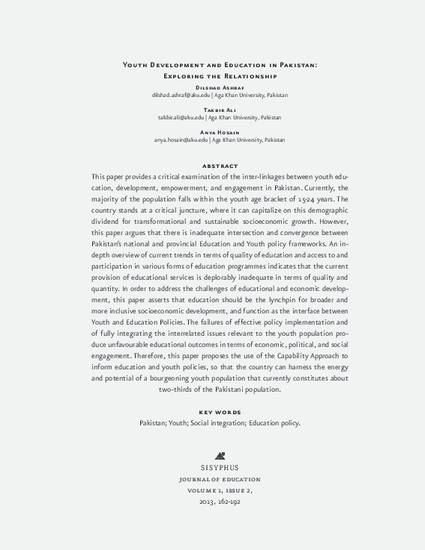
- Adult and Continuing Education Administration,
- Adult and Continuing Education and Teaching,
- Educational Administration and Supervision,
- Educational Leadership,
- Elementary and Middle and Secondary Education Administration,
- Elementary Education and Teaching,
- Higher Education,
- Higher Education Administration,
- Higher Education and Teaching,
- Junior High, Intermediate, Middle School Education and Teaching,
- Other Educational Administration and Supervision,
- Secondary Education and Teaching and
- Teacher Education and Professional Development
This paper provides a critical examination of the inter-linkages between youth education, development, empowerment, and engagement in Pakistan. Currently, the majority of the population falls within the youth age bracket of 15-24 years. The country stands at a critical juncture, where it can capitalize on this demographic dividend for transformational and sustainable socioeconomic growth. However, this paper argues that there is inadequate intersection and convergence between Pakistan’s national and provincial Education and Youth policy frameworks. An indepth overview of current trends in terms of quality of education and access to and participation in various forms of education programmes indicates that the current provision of educational services is deplorably inadequate in terms of quality and quantity. In order to address the challenges of educational and economic development, this paper asserts that education should be the lynchpin for broader and more inclusive socioeconomic development, and function as the interface between Youth and Education Policies. The failures of effective policy implementation and of fully integrating the interrelated issues relevant to the youth population produce unfavourable educational outcomes in terms of economic, political, and social engagement. Therefore, this paper proposes the use of the Capability Approach to inform education and youth policies, so that the country can harness the energy and potential of a bourgeoning youth population that currently constitutes about two-thirds of the Pakistani population.
Ashraf, D., Ali, T., & Hosain, A. (2013). Youth development and education in Pakistan : Exploring the relationship. Sisyphus - Journal of Education, 1(2), 162–192.
